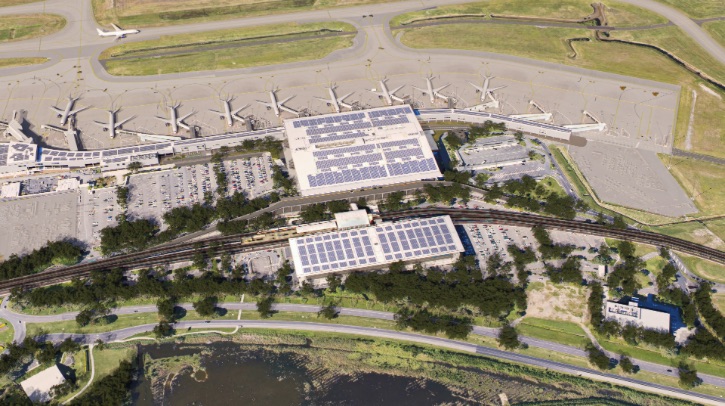Driven by the need to upgrade security screening equipment to meet Australian government standards by the end of 2025, Brisbane Airport is undertaking major works across its International Terminal. This will reportedly include the most significant changes to the terminal since it opened 29 years ago.
The work at the International Terminal is part of the A$5bn (US$3bn) Future BNE transformation that will take place over the coming decade, including upgrades to the Domestic Terminal, construction of Terminal 3, and extensive commercial, retail and industrial projects across the precinct.
Brisbane’s volcanic rock
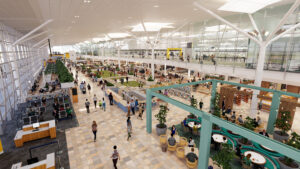
Sustainable design features have been embedded into the project. This includes recycling a volcanic rock called Brisbane tuff. Initially quarried at Kangaroo Point from the 1880s, the material was used in the construction of Brisbane’s oldest buildings.
In 2015, Brisbane tuff was salvaged from demolition yards to create tiles installed in the International Terminal. With those tiles now requiring removal, they’re being crushed and recreated as terrazzo benchtops and furniture in the terminal.
Gert-Jan de Graaff, CEO of Brisbane Airport, said, “The use of Brisbane tuff, originally quarried from Kangaroo Point Cliffs and used in some of Brisbane’s oldest buildings, not only honors the original history of our city but also gives new life to these old and uniquely Queensland materials.”
Optimized staging
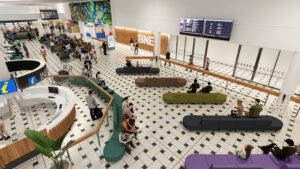
The airport will split the project into 20 phases to minimize impacts on passengers and airlines during construction, which should conclude in 2027.
“As anyone who has ever renovated a house will know, construction comes with challenges, but we are working to keep impacts to a minimum while remaining open and catering for up to 20,000 international passengers a day,” de Graaff continued. “The project is being broken down into 20 construction phases to reduce impacts, but as with all good renovation projects, we know the wait will be worth it. Our International Terminal is Queensland’s gateway to the world. After three decades of service, it’s well and truly time for a transformation, ensuring it’s ready to welcome the world for years to come. This building is worth billions of dollars to Queensland’s tourism economy and jobs every year.”
Security screening and passport control
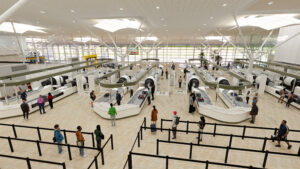
Computed tomography (CT) security screening equipment will be introduced for passengers and baggage. This new equipment is much larger and won’t fit into the existing security area. Therefore, security will relocate from the windowless center of the building on Level 3 to the light-filled atrium on Level 4.
With this technology, passengers can leave items like laptops in their bags and have other loose items screened with their cabin bags thanks to the introduction of larger, deeper screening trays. The new equipment is also expected to increase the speed at which passengers will pass through the screening point. CT screening equipment and the 3D images of bags are also projected to deliver higher levels of accuracy and reduce the need to rescreen bags.
The same technology is being installed in the Domestic Terminal. According to the partners, this is part of the largest airport deployment of Rapiscan systems in Southeast Asia and one of the largest globally. It includes 33 Rapiscan 920CT cabin baggage screening units; 10 Rapiscan RTT 110 checked baggage and oversize screening units; 41 Rapiscan 4DX Explosive Trade Detection units; and 33 Rohde & Schwarz Quick Personnel Security Body Scanners.
Deepak Chopra, chairman and CEO of OSI Systems, the parent company of Rapiscan, said, “We are honored to be part of the biggest transformation in Brisbane Airport history and to strengthen our presence at international airports around the world. This transformative effort will have a significant and lasting impact on all passengers who travel through the airport while increasing the standard of security for both passengers and employees.”
Self-service check-in kiosks and bag drop
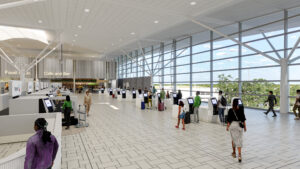
Self-service technology from Amadeus will be deployed at the upgraded International Terminal’s bag drop and check-in. The new technology should reduce queues and let passengers choose between a self-service or agent-led experience.
“The first new-generation check-in row is already up and running, and the feedback from travelers and airline staff has been fantastic. It’s a giant leap from the 1990s to now,” said de Graaff.
Sarah Samuel, senior vice president of airport and airline operations at Amadeus APAC, added, “Brisbane is a great example of an airport with a long-term transformation strategy that places the traveler at the heart of the experience, and we are delighted to support it with our technology. With flexible cloud infrastructure and advanced self-service options, the technology foundations are being laid so Brisbane can offer passengers an outstanding experience for years to come.”
Baggage system improvements
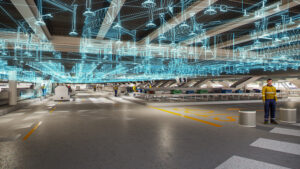
Staged construction is underway on a steel frame mezzanine in the International Terminal baggage area, which will house the airport’s new, energy-efficient conveyor system and Standard 3 technology baggage security screening equipment. This mezzanine level is being built above the existing baggage system to ensure continued operations and minimize the impact on operations during construction. Brisbane Airport has appointed baggage handling company Alstef Group to complete this work.
Retail and duty free
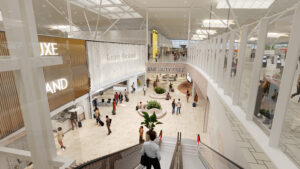
Brisbane Airport’s duty-free area will nearly double in size as part of the redevelopment, and 31 premier retail opportunities will be refreshed. As part of a renewed 10-year partnership with Lotte Duty Free, the expansion will reportedly focus on local brands and sustainability.
Steve Timms, CEO of Lotte Travel Retail Oceania, said, “There is nothing in the Brisbane store design that has similarity to any other place. It will be a bespoke design, capturing the flavor of Brisbane.”
Ground support equipment update
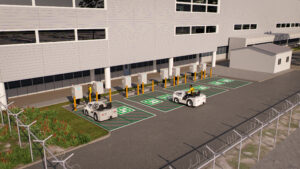
The transformation of the International Terminal will extend outside to the apron, where a network of charging infrastructure tailored specifically for ground support equipment (GSE) will be installed. GSE at airports includes pushback tugs, belt loaders, cargo loaders and baggage tugs used to service aircraft.
“Not only will this convert vehicles from fossil fuels to sustainable sources but it will also make the apron a quieter workplace for the hundreds of people who work loading and dispatching aircraft every day, as well as passengers,” said de Graaff.
Terminal 3
Beyond the renovation of the International Terminal, the airport continues planning for Terminal 3. De Graaff said, “We have begun planning for a Terminal 3 development, which will be conveniently located between our two parallel runways. Eventually we will integrate domestic and international passengers into this new facility. We need to determine whether this integration will happen from day one or in stages. What we know for sure is that sustainability and accessibility will be baked into the design of Terminal 3.”
In related news, Brisbane Airport recently published a request for proposal (RFP) for 32 food and beverage and retail opportunities within the International Terminal, as part of the ongoing transformation of the airport. Click here to read the full story.

